Technical Drawing in Archaeology
- Published: Wednesday, 25 May 2022 09:39
- Written by Jean-Olivier Gransard-Desmond translated by L. Gallet and M. Schmitt
- Hits: 4229
- 25 May
Join Augustin, Alex, Lisa and the whole ArkeoTopia team to discover additional resources for step 6.2 in My Archaeology Book about using artifact illustrations in the lab and the drawing techniques used to make them.
Step 6.2 - In the Lab
Drawing an Artifact for Study
Corresponding pages in MAB1 and MAB2
MAB 1, p. 20 and MAB 2, pp. 26-27
More about this step’s reference artifact
.jpg/98px-Trois_amphores_à_vin,_MSR,_Musée_Saint-Raymond_(7220948998).jpg)
 The drawing in My Archaeology Book titled Drawing an Artifact for Study was inspired by a Roman wine amphora. This process involves applying specific scientific illustration techniques to archaeological research.
The drawing in My Archaeology Book titled Drawing an Artifact for Study was inspired by a Roman wine amphora. This process involves applying specific scientific illustration techniques to archaeological research.
More precisely, this amphora is a Dressel 1B type. The Dressel type amphorae acquired their name from the 19th-century archaeologist who established the typology for these kinds of amphorae, Heinrich Dressel. Among all of the different ceramics studied, the Dressel 1B amphorae are known to have been used for wine production and to date back to the end of the Roman Empire, and were thus produced in Italy.
In order to properly study an archaeological find, archaeologists cannot rely on photographs alone. To ensure a more complete understanding, they need to prepare a technical illustration. At the very least, an illustration is the best way to comprehend the actual dimensions of an archaeological find, as it is much more accurate than photographs. Here is an experiment to do with children: have them describe the amphora in My Archaeology Book, or another object that is easy to draw. Then have them draw the object and describe it to you again. They will realize on their own that by drawing the artifact, they have gained new insight and thus have more information with which to describe it.
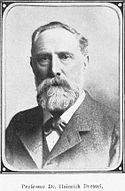 Mastering technical drawing is a learning process in itself. This is why archaeology laboratories often have an on-site illustrator, resources permitting. As for labs that do not have the means to hire an on-site illustrator, the archaeologists themselves take on the illustration work, which can impact the quality of the work depending on the scientists’ drawing abilities.
Mastering technical drawing is a learning process in itself. This is why archaeology laboratories often have an on-site illustrator, resources permitting. As for labs that do not have the means to hire an on-site illustrator, the archaeologists themselves take on the illustration work, which can impact the quality of the work depending on the scientists’ drawing abilities.
In either case, the illustrator uses technical drawing protocols and tools to render a finished product that highlights the object’s real-life characteristics. These drawing protocols include conventions and norms for how objects are represented. For example, in the amphora illustration in My Archaeology Book, the right side of the drawing shows the profile of the artifact while the cutaway drawing on the left side shows its thickness. Illustrators use many tools in order to produce this kind of technical drawing, one of which is called an outside caliper. This tool allows illustrators to measure the differing thicknesses of the ceramic object. The shape and size of the outside caliper used depend on the type of work being done. Another essential tool for technical drawing in archaeology is a profile gauge. A profile gauge is a tool with a great number of sliding pins which, when pressed against an object, conform to the contours of that object and reveal its profile. Obtaining an object’s exact profile allows illustrators to then transfer that line directly onto tracing paper. This process facilitates a 1:1 scale representation of the object.
Illustrators use many tools in order to produce this kind of technical drawing, one of which is called an outside caliper. This tool allows illustrators to measure the differing thicknesses of the ceramic object. The shape and size of the outside caliper used depend on the type of work being done. Another essential tool for technical drawing in archaeology is a profile gauge. A profile gauge is a tool with a great number of sliding pins which, when pressed against an object, conform to the contours of that object and reveal its profile. Obtaining an object’s exact profile allows illustrators to then transfer that line directly onto tracing paper. This process facilitates a 1:1 scale representation of the object.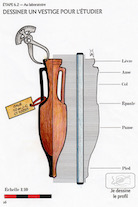 To-scale illustration is a fundamental part of technical drawing as it is the only way to know an object’s real dimensions. Although archaeological illustrations are always published at a reduced scale, the relationship between the stated scale and the drawing’s dimensions allow for the calculation of the object’s actual dimensions.
To-scale illustration is a fundamental part of technical drawing as it is the only way to know an object’s real dimensions. Although archaeological illustrations are always published at a reduced scale, the relationship between the stated scale and the drawing’s dimensions allow for the calculation of the object’s actual dimensions.
Technical drawing in archaeology also requires the use of a legend. The information provided by a legend serves not only to define what is depicted in the image, but also to provide complementary information on the types of lines or coloring techniques utilized by the illustrator that deviate from established norms. There are many resources available on technical drawing in science. Take a look at this textbook on technical drawing to help students learn more about illustration techniques and other aspects of this work. The video below outlines the process of technical pottery drawing in archaeology, and this document details the tools and techniques used in this practice.
Clues
The 8 clues include:
- The outside caliper, which measures the thickness of ceramic objects
- The profile gauge, which facilitates drawing the contours of the artifact to scale
- The artifact itself: in this case, a Dressel 1B wine amphora
- The left side of the image, drawn in dark black cutaway style, distinguishes the illustration as technical or scientific, and not artistic. Archaeologists create representations not only of what is visible, but also characteristics that promote understanding as to how the object was made. In this illustration, for example, the base of the amphora is much thicker than its sides, making the bottom of the container much higher inside than its exterior base
- The artifact’s identification tag, noting the country and date of discovery (Italy, 10 BCE) and its inventory ID number (CT 10ZS5), making it possible for others to revisit the site. In the version for 8-16 y/o, the inventory ID number is not shown, because it was not available. The ceramic is not the same.
- The nomenclature designating different parts of the artifact, which allows for a detailed description of the object
- The scale legend, which allows for the calculation of the actual dimensions of the artifact
Use-Wear AnalysisMy Archaeology Book
Resources HomepageStep 6.1 - In the Lab
Dating Techniques
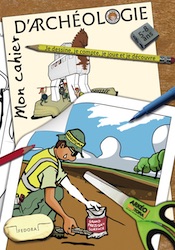 |
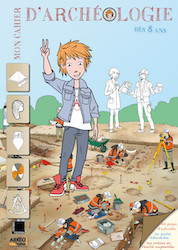 |
|
My Archaeology Book 1 |
My Archaeology Book 2 |
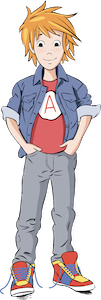
 My Archaeology Book, or MAB, is an activity workbook that combines creativity, fun and learning. Alongside young Augustin, a curious and courageous boy, children meet Alex and Lisa, two friendly archaeologists who will lead them to discover archaeology and French heritage. Each drawing illustrates a situation that Alex and Lisa might encounter at work. Depending on the age of the child and the workbook, children follow easy-to-understand symbols in order to experiment with activities such as coloring, drawing, observation games, riddles and reading in order to see the world through an archaeologist’s eyes. Alone, with family, at school or just for fun, children expand their knowledge and gain skills, all while having fun.
My Archaeology Book, or MAB, is an activity workbook that combines creativity, fun and learning. Alongside young Augustin, a curious and courageous boy, children meet Alex and Lisa, two friendly archaeologists who will lead them to discover archaeology and French heritage. Each drawing illustrates a situation that Alex and Lisa might encounter at work. Depending on the age of the child and the workbook, children follow easy-to-understand symbols in order to experiment with activities such as coloring, drawing, observation games, riddles and reading in order to see the world through an archaeologist’s eyes. Alone, with family, at school or just for fun, children expand their knowledge and gain skills, all while having fun.
On this section, you will find additional resources: color photos of archaeological documents that inspired My Archaeology Book, additional teaching documents (flip-book, websites, suggestions for classroom use, edutainement, etc.) and information on upcoming publications. Each page will be updated over time.






